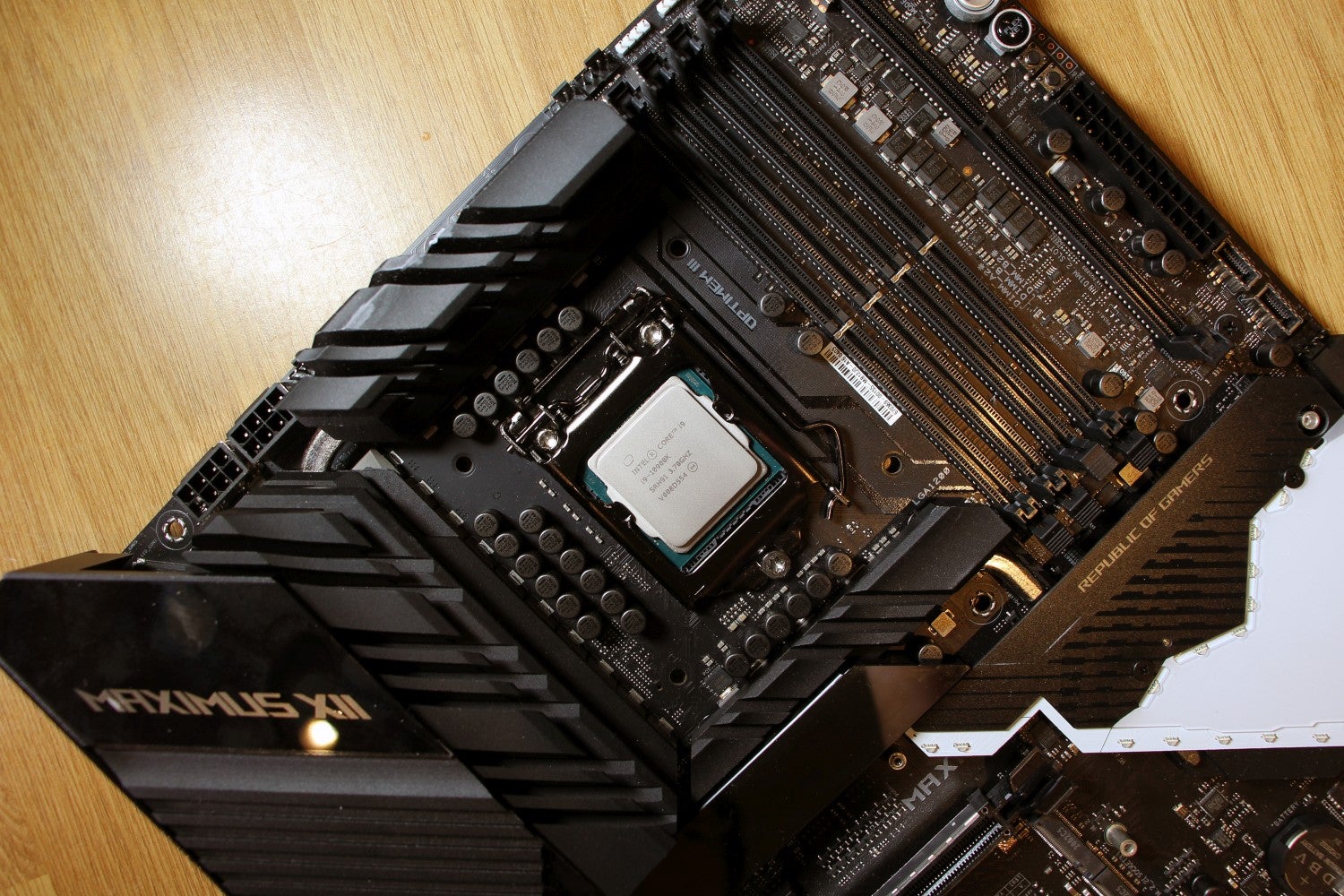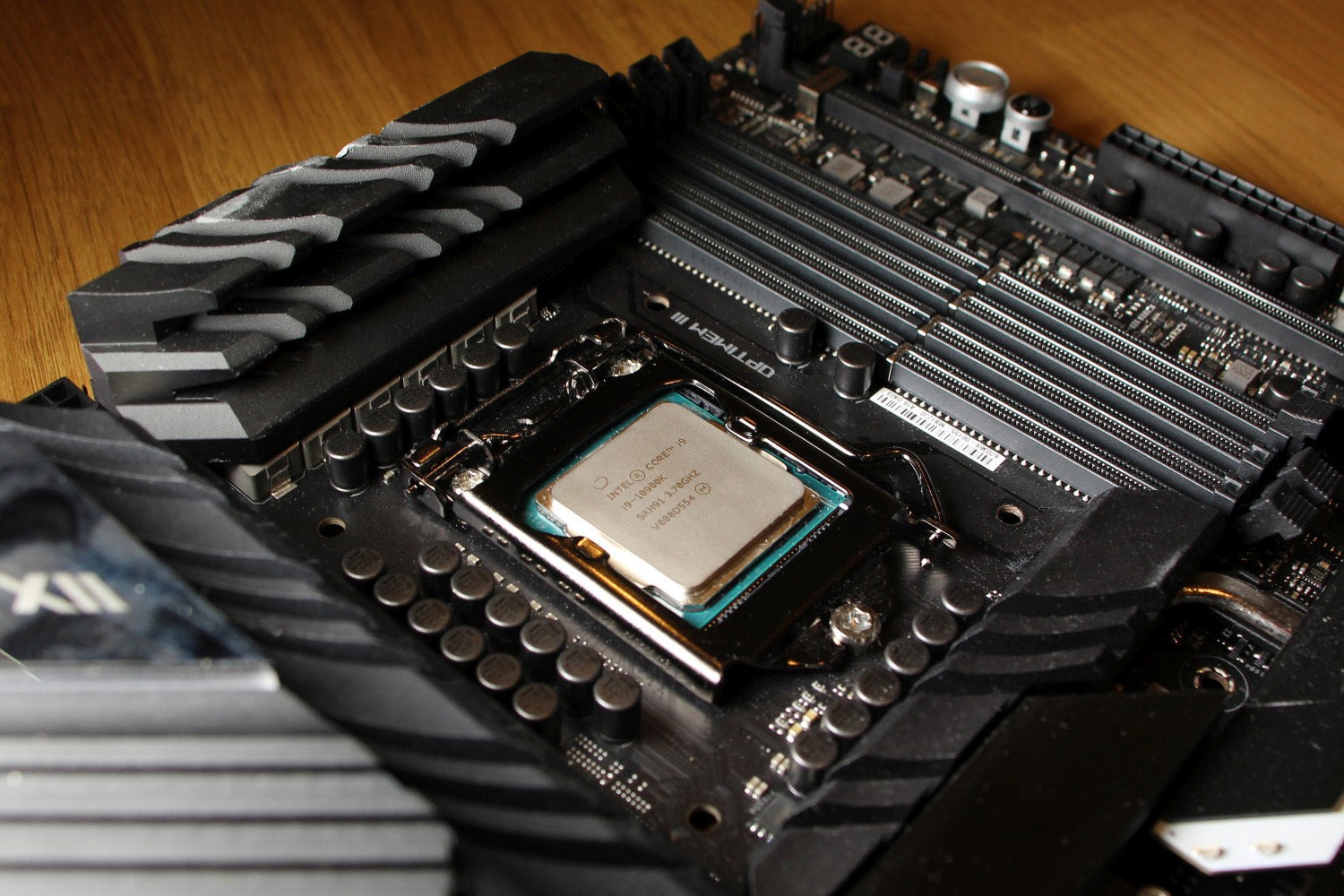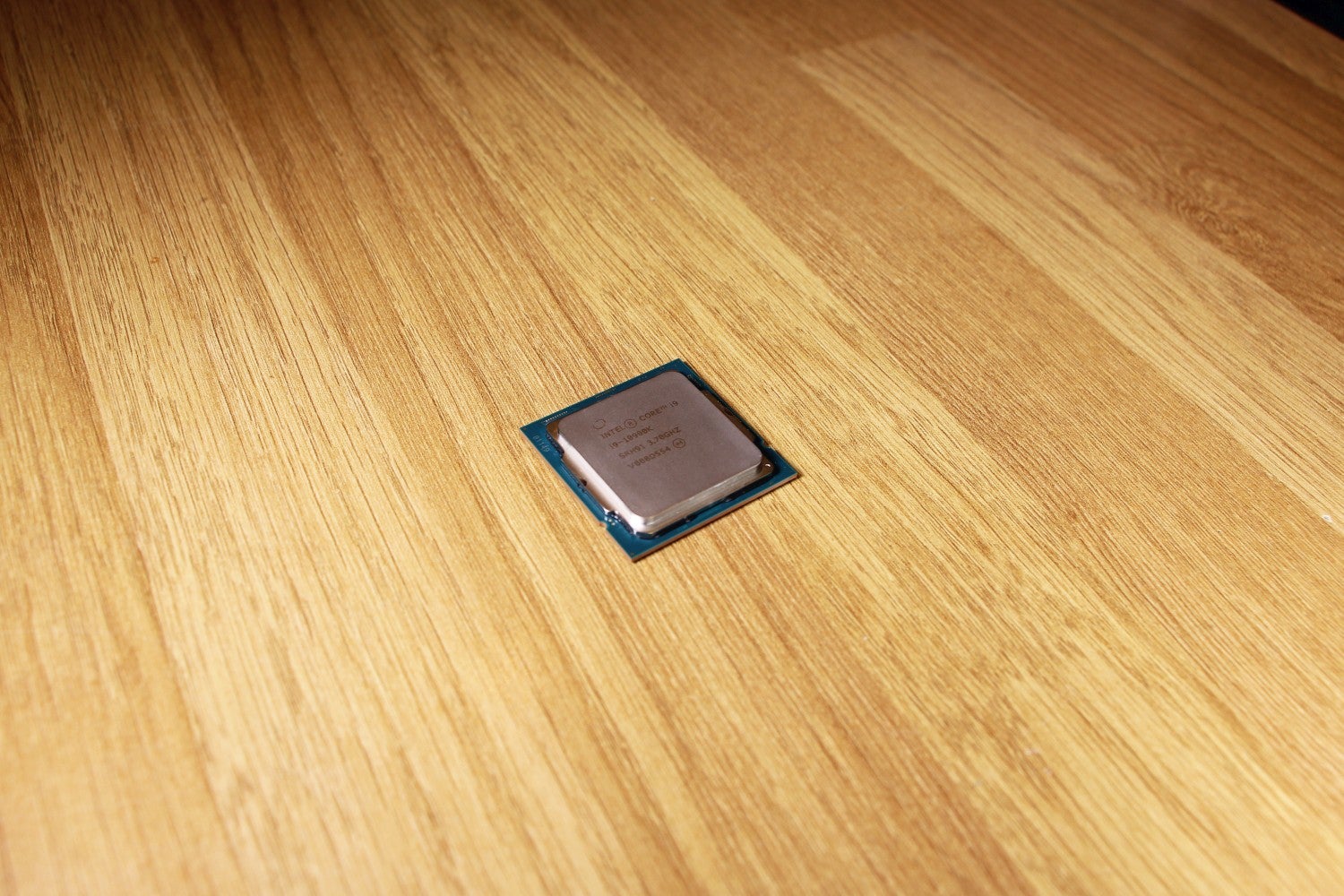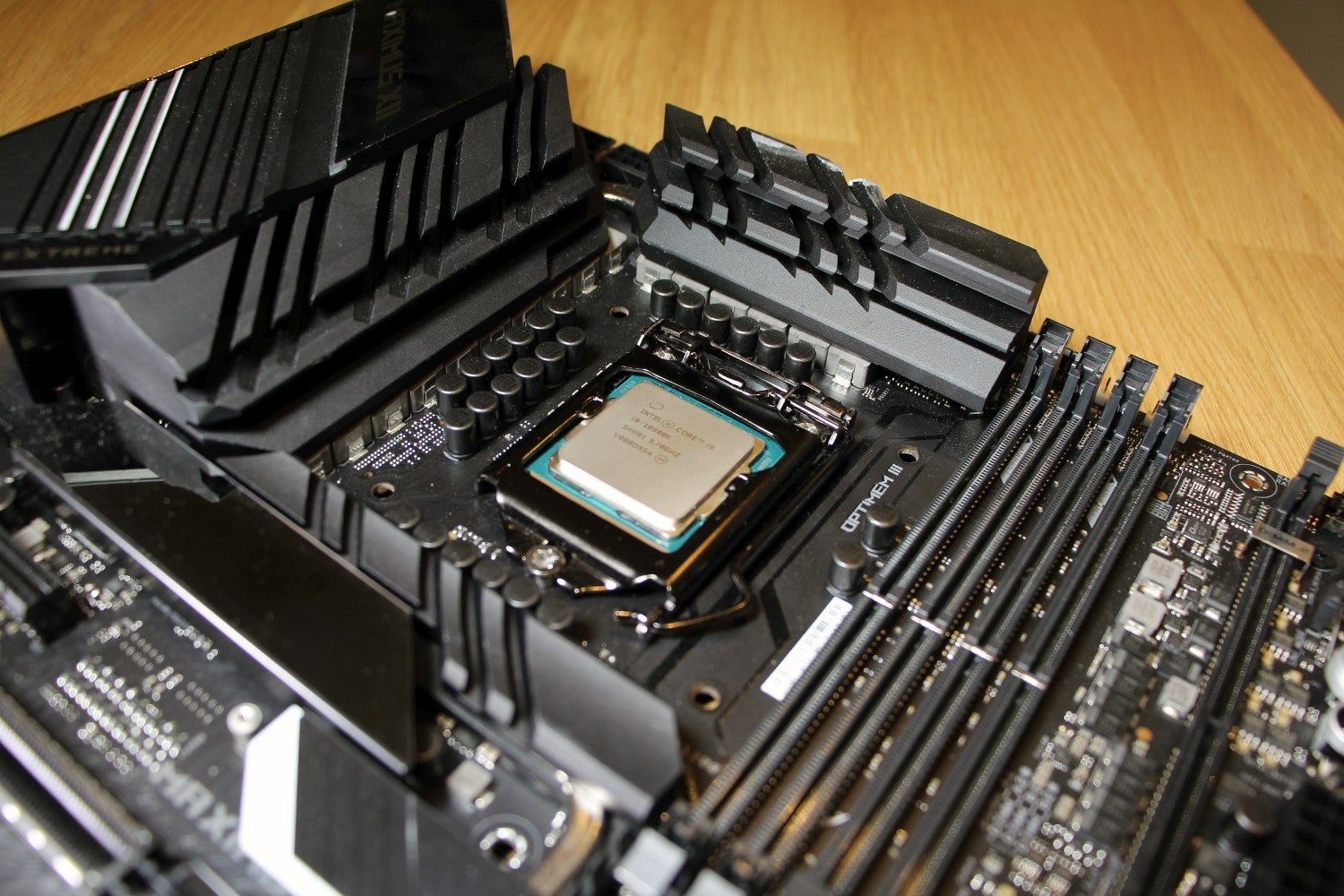Intel Core i9-10900K Review
Intel Core i9-10900K Review
Can the Intel Core i9-10900K use ten Hyper-Threaded cores to take on the might of AMD?
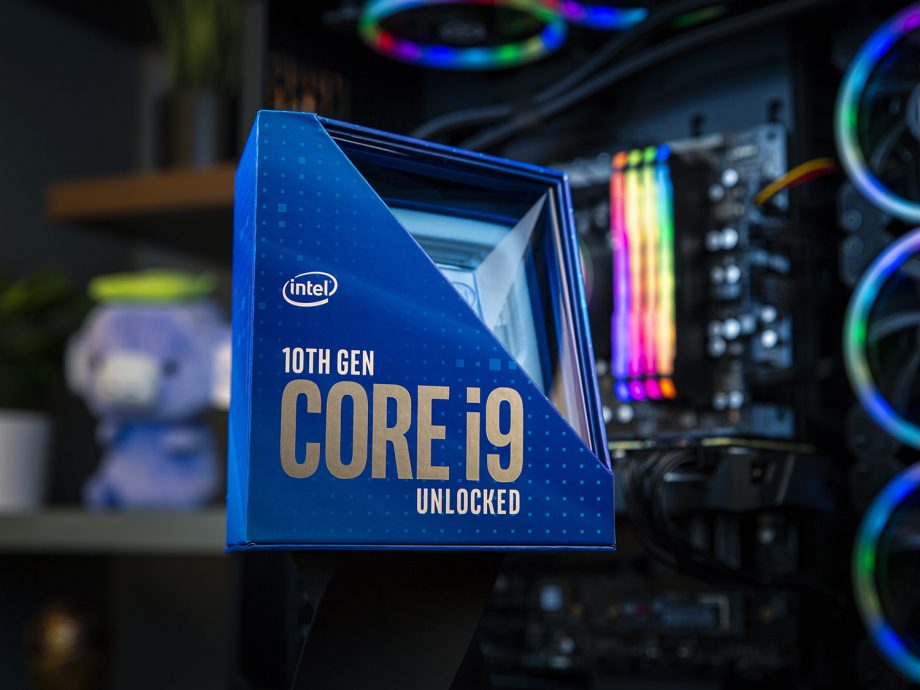
Verdict
The Core i9-10900K is fast in games, single-threaded tasks and day-to-day jobs, but it’s unable to outpace the cheaper AMD Ryzen 9 3900X in tougher workloads, and it’s never dominant in gaming either. Intel’s chip is expensive, its ecosystem is sometimes outdated, and it’s power-hungry. We’d wait to see what the rest of the year has in store before making a buying decision.
Pros
- Impressive single-threaded performance
- Decent gaming pace
- Good performance in day-to-day work
- Chipset with upgraded networking
Cons
- Unable to beat rivals in multi-threaded tests
- Pricier than the competition
- Expensive ecosystem
- No native PCI-E 4.0 support
Key Specifications
- Review Price: £530
- 3.7GHz base clock
- 5.3GHz boost clock
- 10 cores, 20 threads
- 14nm manufacturing process
- Intel Z490 chipset
- PCIe Gen 3 support
The Intel Core i9-10900K is Intel’s latest desktop flagship, and it’s arguably one of the most important releases from the blue team in several years.
After years of unchallenged success in the high-end market, Intel now faces intense competition from AMD – and its Zen chips are getting better, often beating Intel for performance and price.
Intel 10th Gen CPUs – Technology, specifications and chipset
Intel’s 10th Gen chips use a design called Comet Lake, but underneath all of that, they actually use a refinement of the Skylake architecture that’s been around since 2015.
The older underlying architecture means that Intel hasn’t made wholesale changes for its 10th Gen parts – they still use the same 14nm manufacturing process, while AMD moved to 7nm for its Zen 2 chips.
Intel 10th Gen concentrates on more cores, more Hyper-Threading and more boosting – alongside thermal improvements.
The i9-10900K has ten Hyper-Threaded cores – two more cores than its predecessor, the Intel Core i9-9900K. Its 3.7GHz base clock speed is 100MHz higher than that older chip, and it has 20MB of L3 cache – four extra megabytes.
The new chip uses existing Turbo Boost 2.0 technology to reach an all-core Turbo speed of 4.9GHz and a single-core Turbo speed of 5.1GHz, with those speeds 200MHz and 100MHz better than the i9-9900K respectively.
This 10th Gen chip has some extra Turbo tricks up its sleeve thanks to technology borrowed from Intel’s mobile line-up and desktop workstation CPUs.
The first new technology is Turbo Boost 3.0 Max, which has been borrowed from workstation chips. It identifies the CPU’s two most capable cores and gives them an extra boost. On the i9-10900K, it can improve two cores to 5.2GHz.
The second new feature is called Thermal Velocity Boost. This technology originated on laptops, and it gives one core a further boost if it’s running below 70°C. On the i9-10900K, that means a single core peaks at 5.3GHz.
All of this new Turbo grunt does mean increased power demands. The i9-10900K has a 125W TDP, which is more than the 95W i9-9900K and the 105W AMD Ryzen 9 3900X.
To combat this, Intel has made the chip’s die thinner, added a thicker copper heat-spreader and improved its thermal compound.
10th Gen CPUs also have more detailed overclocking. Hyper-Threading can be disabled on a per-core basis, and users get granular options for voltage and frequency adjustments.
Related: Best PC Games 2020
Intel Core i9-10900K – Pricing, ecosystem and competition
The Core i9-10900K costs a hefty £530, and the price of the CPU isn’t the only cost involved here.
For starters, Comet Lake has a new socket – it’s called LGA 1200. That means a new chipset and new motherboards.
The new Z490 chipset is the same as Z390 in most key areas, but it has been upgraded with WiFi 6 and 2.5Gbps Ethernet support.
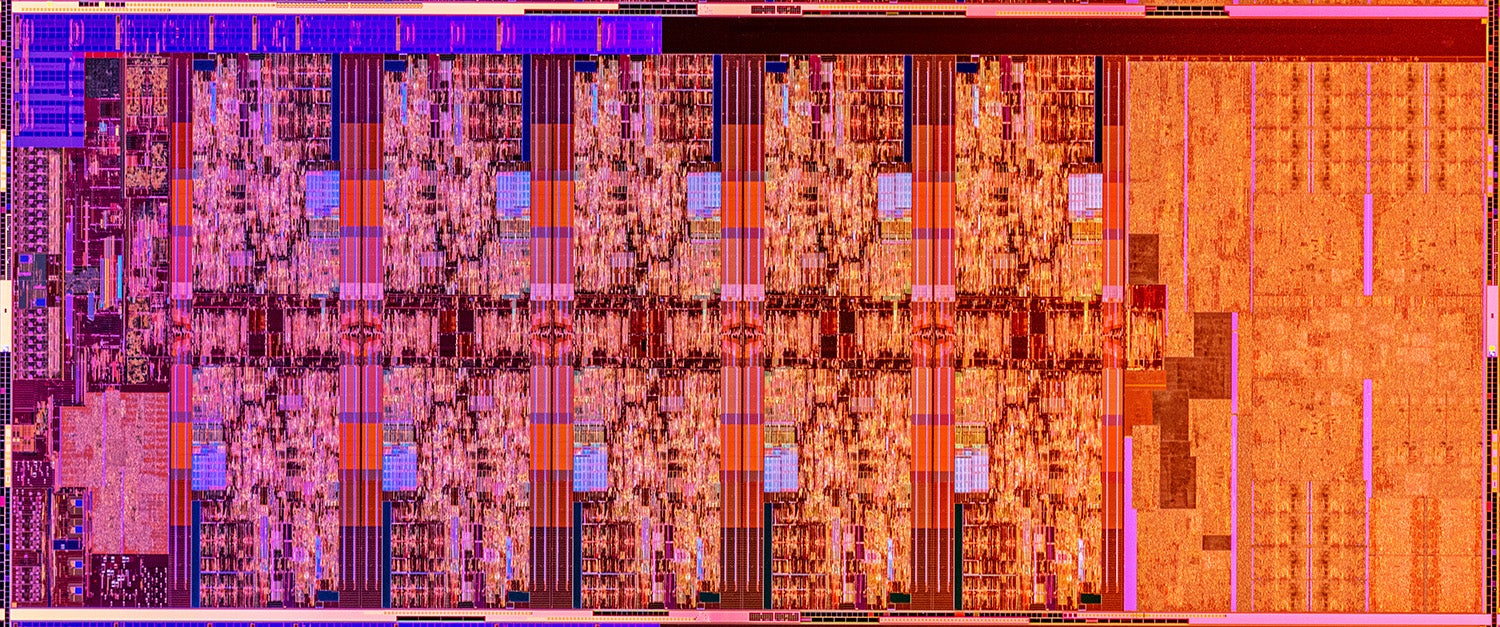
A photo released on April 30, 2020, shows a die from a 10th Gen Intel Core processor. (Source: Intel Corporation)
One area that doesn’t get a speed boost is PCI-Express connectivity. The Z490 chipset still relies on PCI-Express 3.0. That’s fine for today’s graphics cards and popular NVMe SSDs, but AMD has already moved to PCI-Express 4.0 – and faster SSDs are already on the market.
Some motherboard manufacturers have already installed PCI-Express 4.0 on their boards despite Intel’s lack of support. However, this is a risk – while Intel is almost certainly going to include PCI-Express 4.0 on future CPUs, there’s no guarantee, and no telling that Intel won’t change the specification.
At the moment, only Intel Z490 boards are available, which means you’re looking at an extra £130 on top of your CPU. While that may not be a huge sum if you’re planning an i9-10900K build, that’s relatively expensive on a mainstream Core i5 or Core i7 machine. If you’re not fussed about an immediate upgrade, it’s certainly worth waiting for mainstream chipsets and more modest boards.
There’s one bit of good financial news here: the LGA 1200 socket is the same size as its preceding LGA 1151 socket, so existing coolers will still work.
The Core i9-10900K’s main competition comes from AMD. The Ryzen 9 3900X is a compelling rival: it costs £440, and it has twelve cores. The AMD chip has base and boost speeds of 3.8GHz and 4.6GHz, with that latter figure unable to match Intel’s improved boost clocks.
AMD’s chip may save money elsewhere too: its reliance on the existing AMD AM4 socket means it works on a wider, cheaper range of motherboards, and it’s also sold with a basic cooler that’s good enough for mainstream computing.
Related: Best Gaming Laptops 2020
Intel Core i9-10900K – Test setup
In order to ensure a fair test of the Intel Core i9-10900K, we’ve kept our test rig as consistent as possible. This is the specification:
- Motherboard: Asus ROG Maximus XII Extreme
- GPU: Nvidia GeForce RTX 2080 Ti
- Cooler: Corsair Hydro Series H150i Pro RGB 360mm liquid cooler
- PSU: Fractal Design Essence 600W
- SSD: Seagate Barracuda 510 500GB
- OS: Windows 10 Pro 64-bit
The benchmark software is also important. We’ve picked Geekbench, Cinebench and PC Mark 10 – benchmarks that will test for work tasks, day-to-day computing and mainstream office applications.
For gaming, we’ve picked Shadow of the Tomb Raider, Ghost Recon: Wildlands and The Division 2 – modern, tough titles that will make big demands of hardware. We’ve picked Dirt Rally to represent a less-intensive title. We’ve also used Civilization 6, which has a dedicated CPU test.
Games were tested at 1080p, 1440p and 4K and at their highest graphical settings. The exception here is Civilization 6 – its AI test has been run at 4K.
Also bear in mind that changing the CPU isn’t the only thing that will have an effect on gaming performance – driver updates make a significant difference too.
Intel Core i9-10900K – Results
Cinebench R15
Intel’s chip got off to a good start in Cinebench’s single-threaded test. Its result of 225cb delivers a small improvement over the 218cb scored by the preceding i9-9900K, and it’s further ahead of the Ryzen 9 3900X – that chip scores around 212cb.
The Core i9’s good single-threaded performance was undermined by its multi-threaded ability. The i9-10900K scored 2,636cb. That’s almost 600 points better than the older Intel chip, but about 500 points shy of AMD’s twelve-core chip.
Geekbench 4
Unsurprisingly, Geekbench 4 delivered similar patterns. The Intel chip was at its best in single-threaded tests – its score of 6,035 points is 500 points beyond its predecessor and more than 1,000 points ahead of AMD’s chip.
The i9-10900K scored 35,789 in the multi-core benchmarks. That’s not a bad result, but the Ryzen 9 3900X was marginally quicker. It’s another area where Intel can’t surpass AMD.
PC Mark 10
The PC Mark 10 Extended Benchmark is a comprehensive evaluation. The Essentials test covers web-browsing and video-conferencing, and the Productivity test involves Office applications. Both of those areas prioritise single-core speed. The Digital Content Creation benchmark handles photo-editing, video-editing, rendering and visualisation – areas where single-core speed is important, but where multi-core abilities are also relevant.
PC Mark is one area where Intel’s chip did prove dominant. It was almost 1,500 points better than the Ryzen 9 3900X in the essentials test, and it opened a similar lead in the Productivity benchmark.
Interestingly, the Intel chip maintained its lead in the Digital Content Creation test – its score of 12,455 outpaced the AMD chip, which scored 11,394. However, it should be noted that the AMD chip was only around 1,000 points behind, with its extra cores helping to close the gap.
In PC Mark 10’s standard benchmark, the Intel CPU’s score of 7,990 is around 1,000 points better than the AMD chip.
Intel delivered great performance here – the i9-10900K is fast in every test, and it’s quicker than AMD. However, AMD’s multi-core credentials remain strong even in defeat.
Shadow of the Tomb Raider
In this test, the Intel chip performed extremely well. At 1080p and 1440p, its averages of 169fps and 117fps are stellar – better than anything else we’ve tested.
Those scores need to be caveated by the fact that the new chip and Nvidia’s driver updates may have fundamentally changed how this game performs at lower resolutions, but nevertheless, you’re going to have easily enough pace for smooth gameplay.
The Intel was only middling at 4K, though: Its average of 64fps is around ten frames better than the AMD part, but nine frames behind Intel chips with fewer cores. However, activating Ray-Tracing saw that score leap up to 78fps, which makes it faster than Intel’s older parts – as well as delivering improved visual fidelity.
Ghost Recon Wildlands
The new Core i9 chip delivered a solid performance in Ghost Recon: Wildlands. It delivered 1080p, 1440p and 4K averages of 85fps, 70fps and 47fps. The first result is eleven frames better than the older Core i9 chip, the 1440p score is six frames quicker, and the 4K result is level.
They’re good speeds, but they do suggest that the Core i9-10900K delivers less of a performance boost as resolution increases.
The Division 2
The Intel chip also proved weaker at tougher resolutions in The Division 2. While its 1080p framerate of 124fps is a superb result that easily outpaced the older Core i9 and the Ryzen 9 3900X, the i9-10900K delivered an average of 90fps at 1440p – five frames behind the AMD part and eight frames behind the older Intel CPU.
At 4K, the new Intel chip helped our test rig to an average of 52fps. That’s a playable result, of course, but it’s five frames behind other chips.
The Division 2’s results graphs offer some insight here: it’s clear to see the framerate dipping slightly when the CPU has more of a workload at all resolutions.
Dirt Rally
The i9-10900K performed well in Dirt Rally. Its 1080p and 1440p framerates of 151fps and 148fps are far better than any other chip, including last year’s i9-9900K. Happily, at 4K the i9-10900K maintained a score of 123fps – miles ahead of the AMD Ryzen 9 3900X and only three frames back from the older Core i9 chip.
Civilization 6
In the Civilization 6 AI test, the Intel-powered PC took an average of 6.5s to handle turns in this tough, CPU-intensive game. That’s a superb result: a full second ahead of the AMD part and almost one second quicker than last year’s Core i9 CPU.
This bodes well for strategy titles and other games where CPU performance is prized – it suggests that Intel’s latest chip excels here.
Our last benchmark, 3D Mark Time Spy, saw the Core i9-10900K score of 13,693. That’s comfortably ahead of the Core i5-10600K, which scored 12,184, and it’s a handful of points ahead of the Ryzen 9 3900X.
Intel Core i9-10900K – Power consumption and heat
When idling, the test rig with the i9-10900K drew 74W. That’s a decent start – a little more than the i9-9900K but below the Ryzen 9 3900X.
The situation changed when Intel’s ten-core, high-clock chip started running benchmarks. In Cinebench the i9-10900K helped pull 284W from the mains, which is 50W more than the Ryzen chip.
In the Cinebench test with our Corsair Hydro H150i cooler the CPU’s peak temperature of 79°C is absolutely fine. In a stress-test, the chip reached a toasty 91°C, but that’s still easily manageable when using a good cooler – especially because few applications will run all of the CPU’s cores at 100% load for long periods of time.
Should I buy the Intel Core i9-10900K?
The Intel Core i9-10900K is very quick when it comes to single-threaded tasks and mainstream work applications – its results in Cinebench, Geekbench and PC Mark 10 prove that it’s better than its key AMD rival here.
It’s hardly a slouch in games, with a strong result where CPU power is prized and AMD-beating pace in around half the tests – but it’s never dominant, and never really outpaces cheaper 10th Gen chips.
This chip isn’t necessarily designed for gaming or day-to-day computing, though – this ten-core beast will likely be used in systems where productivity, content-creation and tough software is vital. And, in these tests, the Intel chip either fell behind AMD’s older, cheaper chip or only just caught up.
While Intel maintains a lead in PC Mark 10, even here AMD demonstrated that it could succeed in tougher workloads.
There are issues outside of benchmarks, too. Intel’s chip is more expensive than the Ryzen 9 3900X. Intel’s Z490 chipset adds better networking, but its storage and PCI-Express situation still lags behind AMD. Having to factor in a motherboard and cooler may further increase costs when compared to upgrading an existing AMD system – or building one outright.
Intel’s Skylake architecture underpins Comet Lake, but it’s showing its age. AMD’s Zen 3 architecture is rumoured to be launching in the Autumn, and that’ll almost certainly be another multi-core win – and we’d even be tempted to wait around for Intel Rocket Lake, which will likely arrive next year, especially if your current PC is still using relatively modern hardware.
As usual, Intel excels in single-threaded workloads and offers good performance in gaming – but where it really counts, this chip can’t open a lead against its cheaper rivals. While Comet Lake undoubtedly has a place in the modern computing landscape, it’s not at this level when AMD’s Zen 2 hardware is around.


